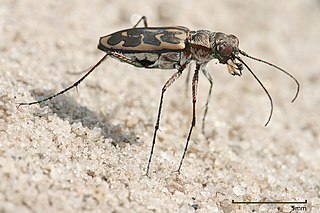
Tiger beetles are a family of beetles, Cicindelidae, known for their aggressive predatory habits and running speed. The fastest known species of tiger beetle, Rivacindela hudsoni, can run at a speed of 9 km/h, or about 125 body lengths per second. As of 2005, about 2,600 species and subspecies were known, with the richest diversity in the Oriental (Indo-Malayan) region, followed by the Neotropics. While historically treated as a subfamily of ground beetles (Carabidae) under the name Cicindelinae, several studies since 2020 indicated that they should be treated as a family, the Cicindelidae, which are a sister group to Carabidae within the Adephaga.

Buprestidae is a family of beetles known as jewel beetles or metallic wood-boring beetles because of their glossy iridescent colors. Larvae of this family are known as flatheaded borers. The family is among the largest of the beetles, with some 15,500 species known in 775 genera. In addition, almost 100 fossil species have been described.

Dermestidae are a family of Coleoptera that are commonly referred to as skin beetles. Other common names include larder beetle, hide or leather beetles, carpet beetles, and khapra beetles. There are over 1,800 species described.
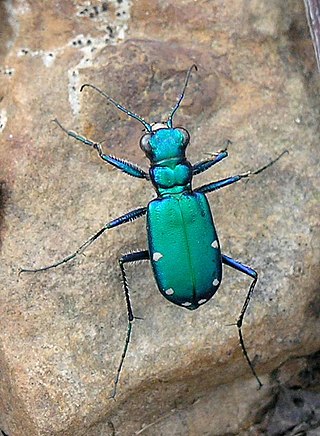
The six-spotted tiger beetle, also known as the six-spotted green tiger beetle, is a common North American species of Tiger beetles in the Cicindelinae subfamily. It is common in many areas of the states, and is well known. It is recognized for its bright green color and its flight pattern. The beetle is largely harmless to humans and may live as long as three years.

Cicindela, commonly known as common tiger beetles, are generally brightly colored and metallic beetles, often with some sort of patterning of ivory or cream-colored markings. They are most abundant and diverse in habitats very often near bodies of water with sandy or occasionally clay soils; they can be found along rivers, sea and lake shores, sand dunes, around dry lakebeds, on clay banks, or woodland paths.
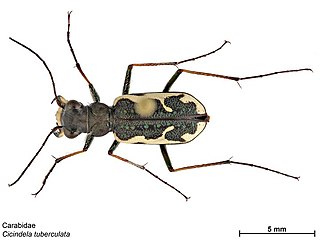
Neocicindela tuberculata is a species of tiger beetle in the family Cicindelidae, endemic to New Zealand. Its common names include common tiger beetle, moeone, and papapa, and in its laval stage penny doctor, butcher boy, kapuku, kui, kurikuri, moeone, and muremure. Neocicindela tuberculata was the first carabid beetle described from New Zealand. The species can run as fast as 5 miles per hour and are considered to be the fastest running beetles. Adult species prefer clay banks in summer and are good predators when in comes to insects.
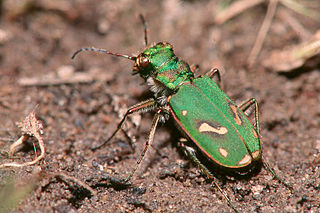
Cicindela ohlone, the Ohlone tiger beetle, is endemic to California. It was discovered in 1987 and named and described in 1993. C. ohlone is most closely related to Cicindela purpurea.
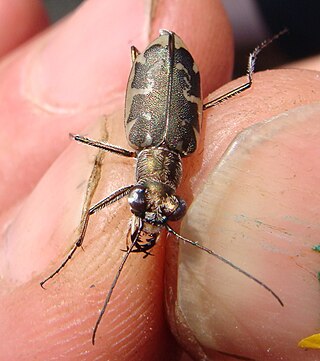
The Puritan tiger beetle is a tiger beetle found in North America. Puritan tiger beetles are found in sandy beaches and rocky cliffs along rivers in Massachusetts, Maryland, and Connecticut. Little is known about this species due to its small geographic range and quickly disappearing populations.

Cicindela hybrida, also known as the northern dune tiger beetle, has a wide distribution in the Palaearctic region. Cicindela hybrida hybrida is common in Central Europe, even in artificial habitats.

Cicindela campestris, commonly called the green tiger beetle, is a widespread Eurasian species of tiger beetle. It is the type species of the large genus Cicindela.

Cicindela duodecimguttataDejean, commonly known as the twelve-spotted tiger beetle, is a species of tiger beetle that is 12–15 millimetres (0.47–0.59 in) long and is dark brown to black. In most of the beetles in the species, there are twelve spots on the elytra. The species widespread throughout eastern North America are commonly found in wet habitats along rivers, moist trails, roads, and paths.
Howard P. Boyd was an entomologist, botanist, editor, teacher, photographer, filmmaker, writer, and naturalist, best known for his close association with the Pine Barrens of New Jersey spanning more than 70 years.

Cicindela albissima, commonly called the Coral Pink Sand Dunes tiger beetle is a species of tiger beetle endemic to Coral Pink Sand Dunes State Park in southern Utah, United States. It was originally described by Rumpp in 1962 as the subspecies Cicindela limbata albissima, but mitochondrial DNA, along with the species' morphological and geographical distinctiveness, have shown that it is a separate species. C. albissima can be distinguished from other Cicindela species by its restricted range and lack of pigmentation on its elytra.
Cicindela denikei, Laurentian tiger beetle is a species of tiger beetle in the Cicindelinae subfamily that can be found in Minnesota, Manitoba, and Ontario. The species have green coloured elytron and is 13–15 millimetres (0.51–0.59 in) long. It can be found in gravel and sand as well as coniferous forests where it preys on other insect species. When it comes to hunting, adults are either wait for their prey in an ambush or chase it. It larvae usually digs burrows in which they wait for their victim to come by. Once an unsuspected arthropod is in sight, it opens it jaws and eats it.

Chlaenius dejeanii is a species of ground beetle native to the Palearctic and the Middle East. It is known from Bosnia and Herzegovina, Greece, Hungary, Israel, Italy, Russia, Syria, Turkey, and Ukraine.

Habroscelimorpha dorsalis, commonly known as the eastern beach tiger beetle, is a species of flashy tiger beetle in the family Cicindelidae. It is found in Central America and North America.

Cicindela scutellaris, the festive tiger beetle, is a species of flashy tiger beetle in the family Cicindelidae. It is found in North America.

Cicindela dorsalis dorsalis, commonly known as the Northeastern beach tiger beetle, is the largest subspecies of Eastern beach tiger beetle. In 2012, Cicindela dorsalis dorsalis was reclassified under the name Habroscelimorpha dorsalis dorsalis, but the names are used synonymously in recently published literature. Fitting to its name, the Northeastern beach tiger beetle dwells along the U.S. northeast coast in small sand burrows. The beetle is diurnal and can be spotted by its light tan coloring with dark lines and green hues on its thorax and head.

Rivacindela hudsoni is an Australian species of the family Cicindelinae or "tiger beetle" and is the fastest-running known insect. The genus Rivacindela is contentiously treated as a subgenus of the broader Cicindela and are typically found in saline habitats such as dry salt lakes and salt streams and are flightless. The species was discovered in South Australia and described in 1997, with an adult form of approximately 20–21mm in length and a running speed of 2.49 m/s, or 120 body lengths per second.


















